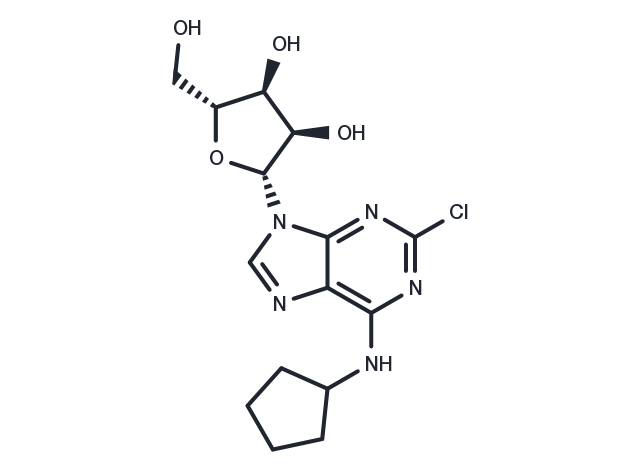Powder: -20°C for 3 years | In solvent: -80°C for 1 year


CCPA (2-chloro-N(6)cyclopentyladenosine) is a potent and selective agonist of adenosine A1 receptor

| Pack Size | Availability | Price/USD | Quantity |
|---|---|---|---|
| 1 mg | In stock | $ 54.00 | |
| 5 mg | In stock | $ 128.00 | |
| 10 mg | In stock | $ 198.00 | |
| 25 mg | In stock | $ 397.00 | |
| 50 mg | In stock | $ 628.00 | |
| 100 mg | In stock | $ 888.00 | |
| 500 mg | In stock | $ 1,770.00 | |
| 1 mL * 10 mM (in DMSO) | In stock | $ 143.00 |

| Description | CCPA (2-chloro-N(6)cyclopentyladenosine) is a potent and selective agonist of adenosine A1 receptor |
| Targets&IC50 | A1 receptor:40 nM |
| In vitro | CCPA suppressed the mRNA and protein expressions of CnAβ and exerted antihypertrophic effects to a greater degree than CsA. The inhibition of CCPA on cardiomyocyte hypertrophy was counteracted by the A1 receptor antagonist DPCPX[1]. |
| In vivo | CCPA (CCPA) was synthesized as a potential high affinity ligand for A1 adenosine receptors. Binding of [3H]PIA to A1 receptors of rat brain membranes was inhibited by CCPA with a Ki-value of 0.4 nM, compared to a Ki-value of 0.8 nM for the parent compound N6-cyclopentyladenosine (CPA)[2]. |
| Synonyms | 2-chloro-N(6)cyclopentyladenosine, 2-CHLORO-N-CYCLOPENTYLADENOSINE |
| Molecular Weight | 369.8 |
| Formula | C15H20ClN5O4 |
| CAS No. | 37739-05-2 |
Powder: -20°C for 3 years | In solvent: -80°C for 1 year
DMSO: 55 mg/ml (148.73 mM)
You can also refer to dose conversion for different animals. More
bottom
Please see Inhibitor Handling Instructions for more frequently ask questions. Topics include: how to prepare stock solutions, how to store products, and cautions on cell-based assays & animal experiments, etc.
CCPA 37739-05-2 GPCR/G Protein Neuroscience Adenosine Receptor 2-chloro-N(6)cyclopentyladenosine 2 Chloro N6 cyclopentyladenosine 2-Chloro-N-6-cyclopentyladenosine 2-CHLORO-N-CYCLOPENTYLADENOSINE 2ChloroN6cyclopentyladenosine inhibitor inhibit
